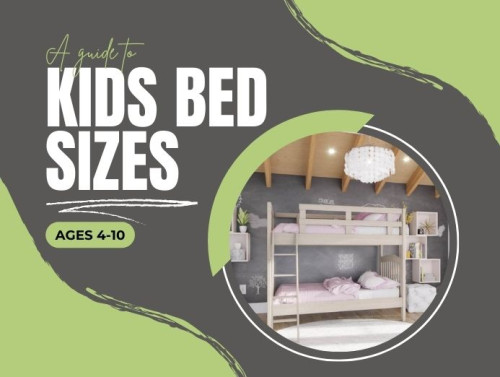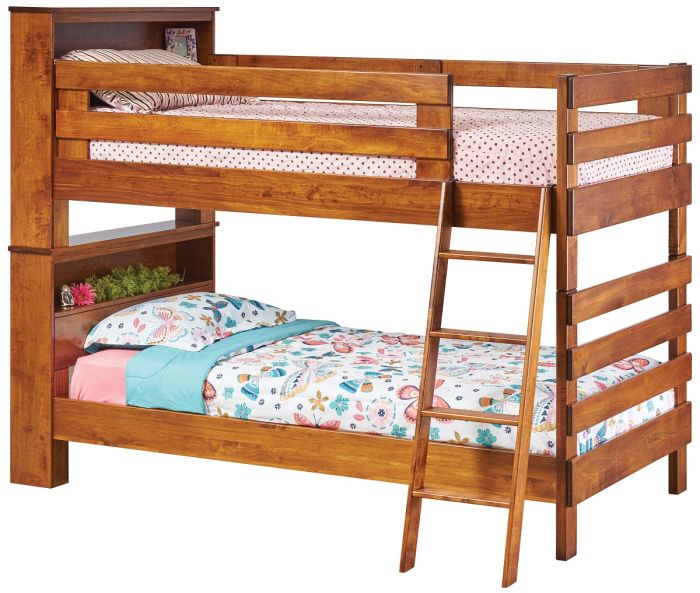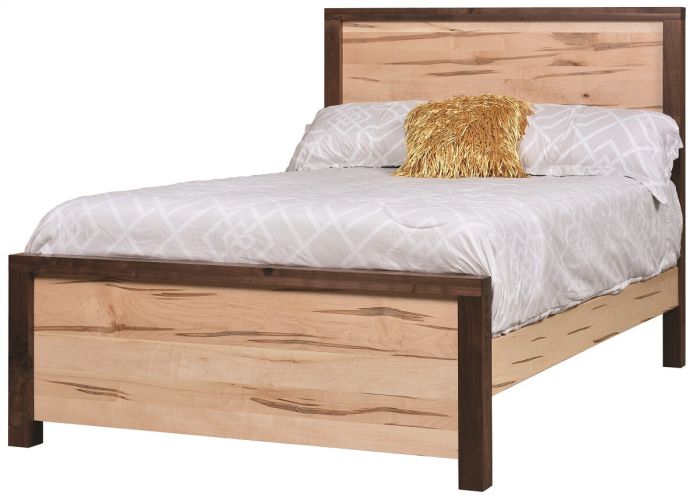Guide to Kids Bed Sizes and Styles - Ages 4-10
By Bailiegh Basham · December 20, 2022
A complaint every parent has from time to time is how quickly their kids outgrow clothes and shoes. However, those aren’t the only things your kids will outgrow. As your child becomes bigger and more capable with age, what they need from a bed will change.
This guide will provide tips for finding the right-sized bed for kids, especially as they hit noteworthy ages 4-10 years old. Plus, we’ll highlight purchasing decisions that let you get the most out of your purchase.
Ready to shop straight into shopping? Check out our Amish-made convertible cribs and youth beds and our favorite cribs shown in oak.
Note About Convertible Cribs for Babies and Toddlers
Cribs are worthy of an entirely separate article, so we won’t dive too much into the subject in this article. However, parents with younger toddlers may want to plan for both today and a few years down the line with a convertible crib (which can turn into a daybed or full bed). Not only does this ingenious furniture piece help you save money, but it can aid with the emotional transition from sleeping with bars to an ordinary bed.
Pictured is the Benham Convertible Crib which starts off as a crib suitable for up to 3 years old. As early as the child is 18 months, parents can transition the crib into a bed. Signs that they’re ready include an eagerness to crawl over the guardrails (which can be dangerous), they no longer have accidents in bed, and exhibit a general restlessness.
Best Bed Sizes & Styles for Children Aged 4, 5, and 6
Most children will be ready for a “real bed” by the time they are 3 or 4 years old, if not sooner. The most logical purchase will be a junior or twin bed set.
Junior or twin bed – which is better for kids ages 4-6? Ultimately, a twin bed just makes more sense considering that the timeframe in which child can get used from a junior bed is limited. What’s more, you don’t have the option of giving it a second life as a guest bed once your child grows into adulthood. Ultimately, if you think you’ll prefer a junior bed, we suggest investing in a convertible crib earlier in the child’s life.
Twin mattresses tend to measure 38” x 75” but, when laying out the child’s bedroom, don’t forget that the bed frame will add additional inches. However, size isn’t the only consideration when choosing a new bed for younger children ages 4-6. Also, keep an eye out for:
- Beds that are low to the ground - Kids won’t want to struggle to climb in and out of bed, so avoid anything too high (anything less than 10” from the ground is ideal). Even if you provide your child with a stool, remember that kids can be prone to accidents, suggesting you wouldn’t want to have them fall from too high. Don’t forget to factor in the thickness of the mattress when assessing your child’s journey from the floor into bed.
- Sturdy construction - To an adult, a bed is a place to sleep. But in the eyes (and imagination) of a 4-year-old? It can become a trampoline, a spaceship to Mars, or a fortified castle in a game of tag. Our point? Your child will put the bed to the test! Look for a frame made with strong materials and reliable construction that won’t buckle under the stomping of feet.
Is there such a thing as too big of a bed for a 4-year-old? Technically, no. However, we assume that most ages 4, 5, and 6 don’t have a master bedroom in the house, meaning that space is limited. With that in mind, think about how little ones like to play; there’s often running or playing with toys on the ground, meaning that kids may appreciate extra floor space more than a larger bed. What’s more, kids will soon come to spend more time in their room, whether it be to do homework or independent activities like reading or coloring. This means the bedroom may need to accommodate a student desk and increased shelving, suggesting that the bed can’t take up too much real estate within the room.
Best Bed Sizes for Children Aged 6 - 9
Children this age should still be able to comfortably sleep in a twin-size bed. Yet, if you’re looking to upgrade, there are new considerations to take into account.
This is the age at which children should safely be able to climb up and down from loft beds unsupervised. What’s more, they’ll demonstrate increasing amounts of independence, meaning that you may not need to read them a “good night book” while perched by their bed (a task made infinitely trickier with a second-level bed. This style of bed frees up more floor space, whether it be for a second bed, shelving, or even a desk.
If this sounds like a style that would benefit your child (or even yourself), check out our Amish-crafted bunk beds and loft beds.
A bed frame that elevates the mattress even a little can grant added storage, something that kids this age will appreciate as they accumulate more stuff. For example, a wooden bed with base drawers can store items that would otherwise be located out of their reach, further enabling them to do tasks without your help. Similarly, you can look for frames with clearance underneath which would accommodate various boxes.
Best Bed Sizes for Children Aged 10 - Tween
Turning 10 years old is an exciting time for kids; middle school is around the corner, interests are rapidly changing, and their bodies are achieving new heights. It’s usually at this age that parents begin to wonder whether they need to upgrade their child’s twin to a full-sized bed.
The good news is that your 10-year-old should be just fine in the twin (for now) unless they roll a considerable amount in their sleep. However, if you’re in the market for a new bed for unrelated reasons, now is the time to upgrade to a full if space allows. Your 10-year-old will continue to grow and, in the years to come, may soon rival your own height! Plus, 10-year-olds and older kids will soon be spending more time outside of the room, whether to join school-run recreational activities or hang out at a friend’s house. While they’ll absolutely appreciate having their own small computer desk, the extra floor space is no longer needed for “play” and can go towards a larger bed.
If upsizing the bed for your 10-year-old, consider getting a frame that offers built-in drawers or under-bed storage. This helps conserve free floor space and can save you the need to buy additional shelving or furniture units.
Considerations When Choosing a Kids’ Bed, Regardless of Age
The recommended firmness of the mattress: A bed is more than merely its frame, as the accompanying mattress plays a large role in your kids’ quality of sleep. Generally speaking, it’s recommended that growing children sleep on medium to high firmness to support their neck and spine.
Ease of cleaning: This philosophy should extend to all elements of the bed, including the bedding and pillows. After all, even older kids may occasionally track in dirt, spill their juice, or have an accident, and you don’t want to have to regularly deal with the complications of silk sheets! In this spirit, we suggest avoiding upholstery and canopy beds that require extra steps to clean.
The style and color should be neutral (skip the novelty bed): Remember, children are fickle. Right now, their favorite color could be yellow but, six months from now, it could be something entirely new. Therefore, resist picking out a bed frame painted or stained to today’s favorite color if it’s an unusual choice. Instead, opt for a neutral color that will accommodate a variety of tastes (including your own).
This suggestion obviously applies to “novelty beds” decorated to reflect the child’s favorite characters or theme. Our take – these are made to last only a short while with subpar materials and an increased likelihood of questionable flame retardant chemicals with potential health consequences. Safety and wellness risks aside, buying a cheaper bed frame that will inevitably end up in a landfill hurts the environment.
There are plenty of other ways to showcase your child’s personality within the bed, such as specialized sheets and pillows.
Have Additional Questions About Bed Types and Sizes for Kids Ages 4-10?
The Countryside Amish Furniture team is here to make the ordering process as smooth as possible. Use the live chat to talk with us today. Alternatively, browse popular bed frame silhouettes including our wooden sleigh beds, Amish-crafted platform beds, and panel bed frames. Can’t decide which type best fits your child’s bedroom? Read our Guide to Bed Frame Styles.
Regardless of which model or size you choose, rest assured that your child’s new bed will be crafted to the highest standards by authentic Amish woodworkers. You get to choose the wood species, as well as the stain or paint (we can send samples to help you decide), making your new purchase truly one-of-a-kind.




